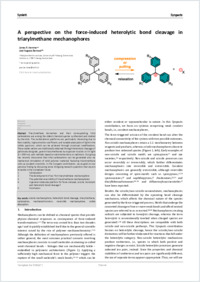A Perspective on the Force-Induced Heterolytic Bond Cleavage in Triarylmethane Mechanophores
DOKPE
- Hemmer, James R. University of Fribourg
- Berrocal, José Augusto ORCID University of Fribourg
- 2022
Published in:
- Synlett. - Stuttgart : Georg Thieme Verlag KG. - 2022, vol. 33, p. 1681-1687
scissile mechanophore
heterolytic bond cleavage
triarylmethane
carbocation
mechanochromism
reversible mechanophore
visible absorption
English
Triarylmethane derivatives and their corresponding trityl carbocations are among the oldest chemical species synthesized and studied by chemists. The carbocationic platforms are particularly interesting due to their stability, high extinction coefficient, and tunable absorption of light in the visible spectrum, which can be achieved through structural modifications. These stable cations are traditionally obtained through heterolytic cleavage of judiciously designed, parent triarylmethanes by exposure to acids or UV light (λ < 300 nm), and methods based on electrochemistry or radiolysis. Our group has recently discovered that trityl carbocations can be generated also via mechanical stimulation of solid polymer materials featuring triarylmethane units as covalent crosslinks. In this Synpacts contribution, we expand on our previous finding by discussing some intriguing research questions that we aim to tackle in the immediate future.
1 Introduction
2 The development of our first triarylmethane mechanophore
3 The potential reversibility of triarylmethane mechanophores
4 A general molecular platform for force-induced, scissile, homolytic and heterolytic bond cleavage?
5 Conclusion
1 Introduction
2 The development of our first triarylmethane mechanophore
3 The potential reversibility of triarylmethane mechanophores
4 A general molecular platform for force-induced, scissile, homolytic and heterolytic bond cleavage?
5 Conclusion
- Faculty
- Faculté des sciences et de médecine
- Department
- AMI - Chimie des polymères et matériaux
- Language
-
- English
- Classification
- Chemistry
- License
- Rights reserved
- Open access status
- green
- Identifiers
-
- DOI 10.1055/a-1854-2131
- ISSN 0936-5214
- ISSN 1437-2096
- Persistent URL
- https://folia.unifr.ch/unifr/documents/327513
Statistics
Document views: 49
File downloads:
- synpacts_220513_clean_berrocal_4.pdf: 129
